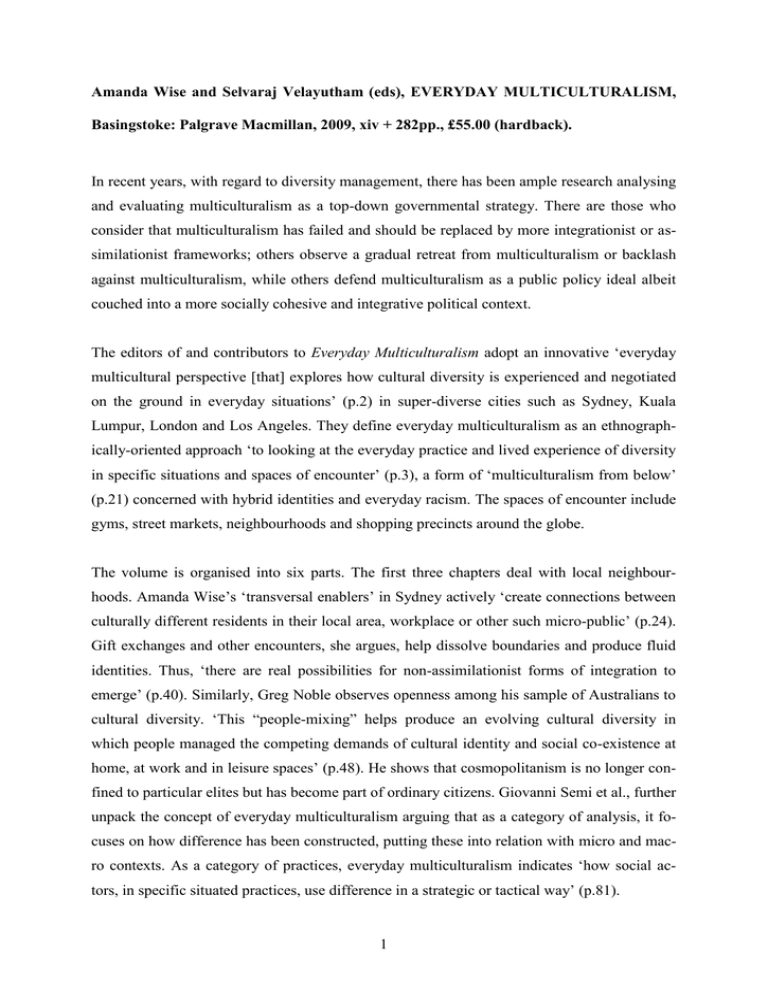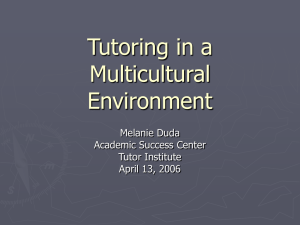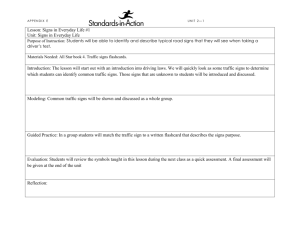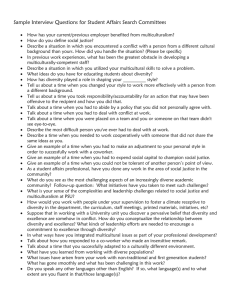Amanda Wise and Selvaraj Velayutham ... Basingstoke: Palgrave Macmillan, 2009, xiv + 282pp., £55.00 (hardback).
advertisement

Amanda Wise and Selvaraj Velayutham (eds), EVERYDAY MULTICULTURALISM, Basingstoke: Palgrave Macmillan, 2009, xiv + 282pp., £55.00 (hardback). In recent years, with regard to diversity management, there has been ample research analysing and evaluating multiculturalism as a top-down governmental strategy. There are those who consider that multiculturalism has failed and should be replaced by more integrationist or assimilationist frameworks; others observe a gradual retreat from multiculturalism or backlash against multiculturalism, while others defend multiculturalism as a public policy ideal albeit couched into a more socially cohesive and integrative political context. The editors of and contributors to Everyday Multiculturalism adopt an innovative ‘everyday multicultural perspective [that] explores how cultural diversity is experienced and negotiated on the ground in everyday situations’ (p.2) in super-diverse cities such as Sydney, Kuala Lumpur, London and Los Angeles. They define everyday multiculturalism as an ethnographically-oriented approach ‘to looking at the everyday practice and lived experience of diversity in specific situations and spaces of encounter’ (p.3), a form of ‘multiculturalism from below’ (p.21) concerned with hybrid identities and everyday racism. The spaces of encounter include gyms, street markets, neighbourhoods and shopping precincts around the globe. The volume is organised into six parts. The first three chapters deal with local neighbourhoods. Amanda Wise’s ‘transversal enablers’ in Sydney actively ‘create connections between culturally different residents in their local area, workplace or other such micro-public’ (p.24). Gift exchanges and other encounters, she argues, help dissolve boundaries and produce fluid identities. Thus, ‘there are real possibilities for non-assimilationist forms of integration to emerge’ (p.40). Similarly, Greg Noble observes openness among his sample of Australians to cultural diversity. ‘This “people-mixing” helps produce an evolving cultural diversity in which people managed the competing demands of cultural identity and social co-existence at home, at work and in leisure spaces’ (p.48). He shows that cosmopolitanism is no longer confined to particular elites but has become part of ordinary citizens. Giovanni Semi et al., further unpack the concept of everyday multiculturalism arguing that as a category of analysis, it focuses on how difference has been constructed, putting these into relation with micro and macro contexts. As a category of practices, everyday multiculturalism indicates ‘how social actors, in specific situated practices, use difference in a strategic or tactical way’ (p.81). 1 The subsequent two chapters focus on food. Gaik Cheng Khoo explores the role of ‘kopitiams’ (coffee shops that serve food) in Malaysia. He discusses the disjuncture between public discourses of kopitiams as cosmopolitan spaces and their reality as rather exclusively Chinese (and to some extent Indian) spaces, a form of ethnic-minority resistance against the Malay majority (p. 88). Despite Islamisation, he maintains that the kopitiam remains part of Malaysian identity and a symbol of everyday conviviality in a multiracial society. Jean Duruz then examines the culinary biographies of two older white women living close to ethnically diverse shopping streets in London and Sydney. She found unexpected engagements with Asia and Europe as well as cosmopolitan identities, not just British and Australian identities. In part three, the focus turns toward shopping precincts. Sophie Watson explores ‘contrasting spaces of multicultural diversity’ (p.126) in two London markets. While her interviewees referred to Queen’s Crescent in Camden in nostalgic terms with resentment toward newcomers for its demise, Ridley Road in Hackney retained its sense of community where intercultural connections are typical, ‘not steeped in tension, hostility or complex power relations. Rather, what is performed in this space are casual encounters and “rubbing along” in this rather ramshackle but richly diverse commercial space’ (p.137). In chapter seven, Martha Radice explores ‘how diverse everyday users of local commercial streets engage with ethno-cultural difference, as represented by the other users they encounter’ (p.140). Similar to Watson, Radice observes that cosmopolitan ideas play out differently in different micro-contexts. The two chapters in part four deal with leisure. Jamie Sherman’s interviewees in a gym in Brooklyn moved back and forth between ethno-racial stereotypes and fluid identities. ‘Hierarchies of power within the gym (...) while rooted firmly within and upon bodily form, rely on criteria that escape the dynamics of racial and ethnic difference’ (p.172). These differences, she argued, served to mark and reconcile other relationships of power within the localised hierarchy of the gym itself. Heather Goodall et al. explore fishing cultures among diverse groups of migrants who fish in Sydney’s Georges River. Their interviewees described the complex and satisfying social processes within their own community of sharing fishing time (p.191). There were also descriptions of cross-cultural interactions in a country where relations between Arabic-speaking and other Australians have become increasingly difficult. Part five focuses on everyday solidarities and politics. Maria Hudson et al. analyse the relationships of residents in a diverse neighbourhood in Manchester. They found that younger 2 people had more ethnically mixed friendship groups and also more positive attitudes to diversity compared with older people and recently arrived Somalis. Although all ethnic groups ‘viewed diversity positively’ (p.208), dissonance was created through non-mixing with newcomers, language barriers and stereotyping. Francis Collins discusses encounters of Asian (mostly South Korean) students in Auckland with New Zealanders as part of voluntarilyorganised rubbish collection in the city centre. She found that ‘it was quite common for passers-by to interact with members in both positive and negative ways’ (p.228), thereby bridging the socio-cultural distance that usually marginalises Asian students in New Zealand. Finally, there are two chapters on everyday tensions. Chong-suk Han who analyses Korean and Latino relations argues that ‘the structure of Korean American-owned stores relegates Latino workers to more difficult and less lucrative positions and Korean Americans to more privileged positions’ (p.238). These hierarchies shape the nature of ethnic conflict between these two communities. Selvaraj Velayutham delves into ethnic tensions in Singapore. A racialised economic hierarchy places the Chinese at the top, the Malays at the bottom and the Indians in-between while the latter group experiences various forms of racism in many aspects of Singaporean life including name calling and racist jokes as well as distrust. This interdisciplinary volume contains an impressive collection of multicultural encounters and is both methodologically and theoretically innovative. An engagement with the commonalities and differences between (everyday) multiculturalism and interculturalism would have been helpful to juxtapose the volume’s key concept with Lentin’s ‘rather active agents who, given half a chance, enact their own politics and interculturalism from below’ (e.g. Ronit Lentin, Turbans, Hijabs and other differences: ‘Interculturalism from below’ and the crisis of (Irish) interculturalism, European Journal of Cultural Studies, forthcoming 2011). I would have also liked to see more diverse cities and countries involved that have not embraced multiculturalism as a public policy to compare how multiculturalism works on the ground in these contexts given the historically more monocultural framework at macro-political level. In sum, this accessible and methodologically innovative volume should be required reading for anyone interested in multiculturalism, immigrant incorporation and ethnographies. Daniel Faas Trinity College Dublin Department of Sociology E-mail: daniel.faas@tcd.ie 3


